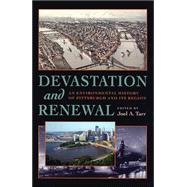Devastation and Renewal
, by Tarr, Joel A.- ISBN: 9780822941569 | 0822941562
- Cover: Hardcover
- Copyright: 12/1/2003
Nineteenth- or early twentieth-century visitors to Pittsburgh were frequently shocked by the ways the industrial environment dominated the natural landscape. Steel mills sprawled across hundreds of acres along the rivers. Land and waterways were crisscrossed by dozens of bridges (some carrying molten iron), miles of railroad track, pipelines, and a net of electrical, telephone, and telegraph wires. Pittsburgh's rivers ran brown from the toxic chemicals, sewage, and refuse that filled them. Coal mines, coke ovens, and their huge piles of debris and ash waste littered the bald, muddy hills. After forests were cut down for fuel, the remaining flora and fauna died from the acidic effluents, garbage, and slag that piled up. Street lamps glowed day and night to compensate for the morass of thick, black smoke that hung in the air, and citizens became accustomed to dramatic displays of light, color, and sound, as the mills issued jets of flaming gas, black smoke, and white steam into the sky. Amidst this churning machine of capitalism, workers dwelt where they could, in rickety row houses built into the overused hills, often accessible only by steep and winding alleys of stairs, and without sewers or proper drinking water. As James Parton succinctly commented in 1866, Pittsburgh was "hell with the lid taken off." Today, the steel industry that defined Pittsburgh for over a century is virtually gone. The sky is blue, fish swim in the rivers, and the hillsides are green and lush. The people enjoy access to many large public parks and trails.






